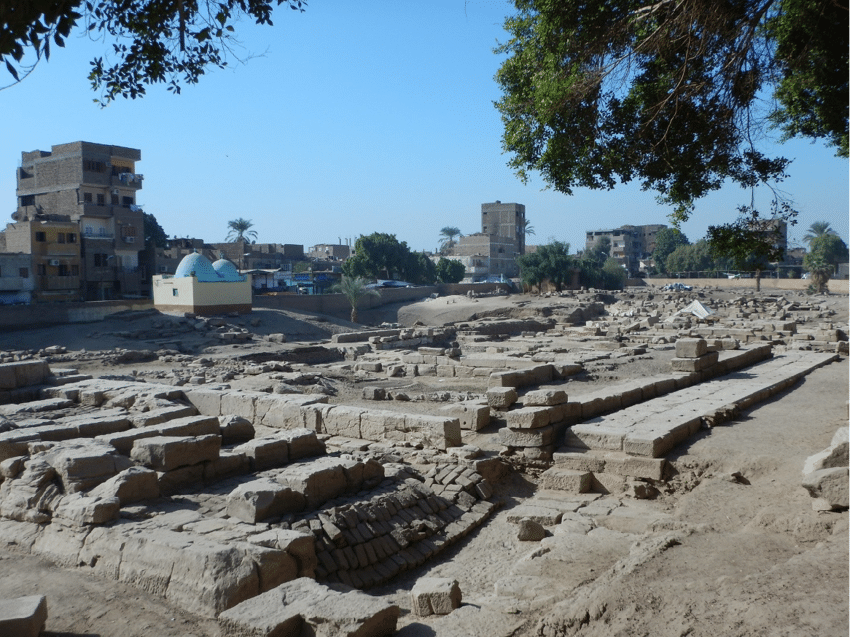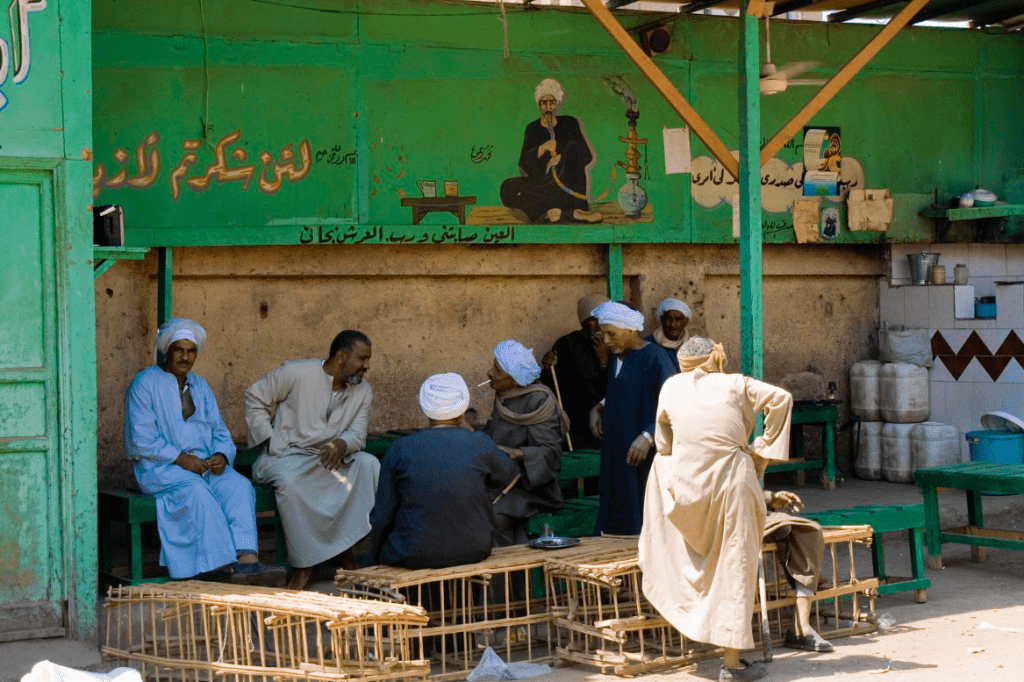Armant: A Journey Through Time
Hermonthis in ancient times
Armant, is located on the west bank of the majestic Nile River, 15 km south of Luxor. Armant—also known as Arment—is a city that whispers secrets from the distant past.

Ruined of Hermonthis

At the heart of modern Arment lies the ruined of Hermonthis. Its weathered stones and faded inscriptions evoke a sense of mystery, inviting visitors to step into a forgotten era. Dedicated to the god Montu, this temple once buzzed with life—priests chanting hymns, offerings laid at the deity’s feet, and the faithful seeking blessings. Today, it stands as a silent witness, its grandeur reduced to fragments, yet still echoing the devotion of centuries past.
The Temple of Montu
Montu, the central figure of the temple, was no ordinary deity. His name, rooted in the word “nomad,” conjures images of vast deserts and untamed wilderness. He embodied the strength of raging bulls, the ferocity of battle, and the unwavering spirit of warriors. Legend has it that Montu manifested himself as a white bull with a black face—a symbol of power and divine presence.

The main god of the Theban area since the 11th dynasty, before the emergence of Amun-re at the beginning of the 12th dynasty. He was worshipped here with his divine consort rattawy/tjenenet/iunyt. The temple of Montu dates back to the middle of the new kingdom. The limestone Middle Kingdom temple was completely dismantled and reused in the foundations of the late Ptolemaic temple, especially in the naos built in the name of Ptolemy xii neos Dionysus auletes. Attested kings from the 11th and 12th dynasties, found on temple reliefs or statues, are nebhepetra Amenhotep II; Seankhkara Menduhotep II; Amenemhat I; Senusret I and III; and Amenemhat II. The new kingdom temple, made of limestone and sandstone, was erected by Thutmose III and Hatshepsut.
The stones from this were later reused in the pronaos. Other kings from the 17th and 18th dynasties are attested on stelae, statues, or blocs: kamose, Ahmose I, Amenhotep II, Thutmose IV, Amenhotep III, and Amenhotep IV (Theban talatats). Only the new kingdom of Pylon was kept at its original location. It bears a famous depiction of a rhinoceros, several Nubians bringing offerings. Until now, there has been no clear evidence to support the traditional dating of this relief to the reign of Thutmose III, even if the famous stela Cairo je 66377 of this king mentions a Nubian rhinoceros. On the eastern wing of the pylon, the remaining reliefs of the lower register bear the name of Rameses iii. On the eastern door jamb of the gate, three lines of a five-line inscription in the name of Rameses ii were recut by Merenptah, Amemmes, Seti ii, Rameses iv, and Rameses vi. The entrance wall (east side) bears the names of Rameses II. Merenptah also reused Osiris colossi, generally thought to have been made originally for Mentuhotep III. Nektanebo II was also constructed at Armant.

Even if some blocks from a gate bear the name of Ptolemy vi philometor, the temple of Montu-ra seems to have been built anew during the reign of Ptolemy xii, mostly attested in the crypts and on numerous scattered blocks. The names of Roman emperors are present on scattered blocks (Nero, Vespasian, Hadrian) and at the gate of bab El-maganiˆn (Antonius Pius), built at some distance from the main temenos. During the Coptic period, an important settlement was built around the new kingdom pylon and in the main courtyard, and a basilica was also erected south of the temple. Close to the temple and the sacred lake, a mammisi was built during the reign of Cleopatra vii and her son Ptolemy xv Caesar in honor of Rattawy and his son Harpra-thechild. This temple was completely dismantled in 1861–2 to build the sugar cane factory at Armant.

The bucheum/bucheion, the burial place of the buchis bulls, sacred to Montu, is located at the desert edge, north of the city. The bulls were buried here from the time of Nektanebo II until the end of paganism in Egypt: the last buchis was buried on November 4, 340 CE, during the reign of Constantius II. North of this area, on the site of baqaria, the buchis’ mothers were also buried. As lord of Armant, Montu was attested since the first intermediate period in the Theban tomb 186. The theology of Montu was influenced by Heliopolitan tradition, as Armant was the “southern Heliopolis.” thereby, Montu was a solar god, especially in his name of Montu-re (until the Ramesside period) and Montu-re Horakhty. As a warrior god, he was worshipped also in the temples of Tod, Medamud, and north-Karnak, these three cities with Armant (“Theban palladium”) having been charged with the protection of the city of Thebes. Montu was also venerated as a form of Osiris at Armant, especially in the Ptolemaic crypts, which seems closely linked to the djemaic rituals from Medinet Habu: once a year, on the twenty-fourth day of the month of Khoiak, Montu from Armant visited Amun and the gods of the mound of djeme. In the crypts, he was “Montu-re, lord of armant, king of the gods, Osiris whose limbs are completed, father of the fathers of all the gods.”
Luxor Tours & Activities
Looking to save some costs on your travel? Why not join a shared group tour to explore Luxor, Egypt? Here are some activities you might be interested in:
Changing Names, Unchanging Significance
Arment’s identity has shifted over millennia, much like the sands of the desert. In ancient times, it bore the name “Anu Ka’net”, signifying the “City of the Sun.” Later, it became “Iun-Montu”, honoring the god Montu. The Greeks knew it as “Hermouthis”, and in Coptic, it transformed into “Hermant” or simply “Armant”. Each name etched a chapter in its story, a testament to its enduring significance.

Off the Beaten Path

Armant is not a bustling tourist hub, and therein lies its charm. Here, you won’t jostle through crowds or queue up for selfies. Instead, you’ll wander through narrow streets, greeted by curious glances from locals who know their city’s hidden treasures.

Sugarcane Fields
Arment’s heartbeat pulses through its sugarcane fields. The rhythm of planting, tending, and harvesting weaves a tapestry of sustenance. And don’t miss the desert village of Zaher Al-Sahrawi, where life unfolds against a backdrop of golden sands and endless horizons.

The administrative division of Armant
Armant City: Comprising Armant Al-Wabourat and Armant Al-Heet.
Al-Riyayna Village: The main village in this unit.
Al-Razeekat Village: Both Al-Razeekat Bahri (north) and Al-Razeekat Qibli (south).
Al-Mahamid Village: Al-Mahamid Bahri (north) and Al-Mahamid Qibli (south).
Al-Democrat Village: Located near Bahgir Al-Mahamid.






